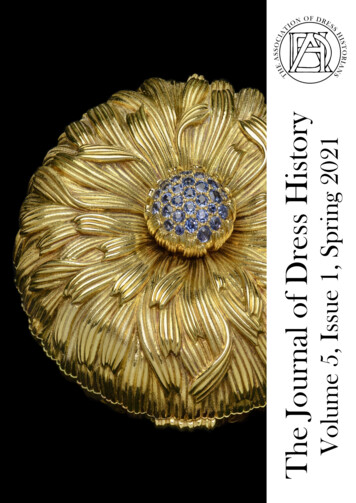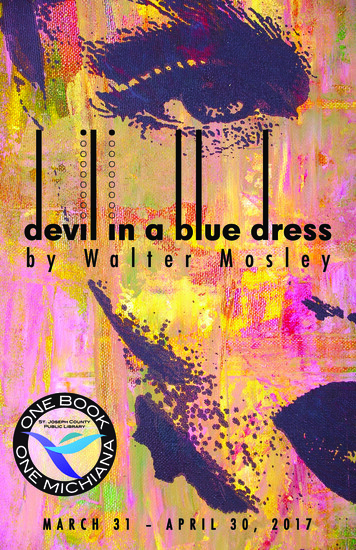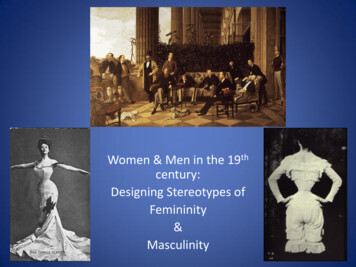
Transcription
Volume 5, Issue 1, Spring 2021The Journal of Dress History
Front Cover Image:Detail, Dahlia Compact, 1959, American, 18k Gold with 30 Montana Sapphires,Diameter 7cm (2 ¾ inches), Designed by Jean Schlumberger (1907–1987), Made byLouis Feron Inc. (1958–2004), Retailed by Tiffany & Co. (1837– ), Owned by RachelLowe Lambert “Bunny” Mellon (1910–2014), Museum Purchase with FundsDonated by the Rita J. and Stanley H. Kaplan Family Foundation and Jean S. andFrederic A. Sharf, The Museum of Fine Arts, Boston, Massachusetts, UnitedStates, 2015.150.1–3.The gold dahlia compact features a cluster of blue sapphires (approximately 1.25carats), forming the stamen and pistils. The compact interior is fitted with a mirror,powder puff, and screen. Marked along the interior edge (at the base of the mirror)are the words “Tiffany” and “Schlumberger–5.” This artefact is in the collection ofThe Museum of Fine Arts, Boston, which houses one of America’s best collectionsof jewellry and objects of adornment. Founded in 1870, the museum has morerecently made jewellry a focal point of the department of Textile & Fashion Arts withthe endowment of the Rita J. Kaplan and Susan B. Kaplan Curator of Jewellry andrelated jewellry gallery. Objects, like the gold dahlia compact, tell the story not onlyof the designer and retailer but also of the fabricator and the former owner and greatlycomplement the museum’s world class collection of garments and accessories to morefully showcase historic dress.
The Journal of Dress HistoryVolume 5, Issue 1, Spring 2021Editor–in–ChiefAssociate EditorAssociate EditorAssociate EditorAssociate EditorEditorial AssistantEditorial AssistantEditorial AssistantJennifer DaleyGeorgina ChappellMichael Ballard RamseyBenjamin Linley WildValerio ZanettiSkye MurieJeordy RainesVanessa RecinePublished Quarterly ByThe Association of Dress orians.org/journal
The Journal of Dress HistoryVolume 5, Issue 1, Spring .org/journalCopyright 2021 The Association of Dress HistoriansISSN 2515–0995Online Computer Library Centre (OCLC) Accession #988749854The Journal of Dress History is the academic publication of The Association of DressHistorians (ADH) through which scholars can articulate original research in a constructive,interdisciplinary, and peer reviewed environment. The ADH supports and promotes thestudy and professional practice of the history of dress, textiles, and accessories of all culturesand regions of the world, from before classical antiquity to the present day. The ADH isRegistered Charity #1014876 of The Charity Commission for England and Wales.Founded in 2016, The Journal of Dress History is published quarterly. It is circulated solelyfor educational purposes and is non–commercial: journal issues are not for sale or profit.The Journal of Dress History is run by a team of unpaid volunteers and is published on anOpen Access platform distributed under the terms of the Creative Commons AttributionLicense, which permits unrestricted use, distribution, and reproduction in any medium,provided the original work is cited properly. Complete issues of The Journal of DressHistory are freely available on the ADH website, www.dresshistorians.org/journal.The Editorial Board of The Journal of Dress History encourages the unsolicited submissionfor publication consideration of academic articles on any topic of the history of dress, textiles,and accessories of all cultures and regions of the world, from before classical antiquity to thepresent day. Articles and book reviews are welcomed from students, early careerresearchers, independent scholars, and established professionals. If you would like to discussan idea for an article or book review, please contact Jennifer Daley, Editor–in–Chief of TheJournal of Dress History, at email journal@dresshistorians.org. For updated submissionguidelines for articles and book reviews, please consult www.dresshistorians.org/journal.The Journal of Dress History is designed on European standard A4 size paper (8.27 x 11.69inches) and is intended to be read electronically, in consideration of the environment. Thegraphic design utilises the font, Baskerville, a serif typeface designed in 1754 by JohnBaskerville (1706–1775) in Birmingham, England. The logo of The Association of DressHistorians is a monogram of three letters, ADH, interwoven to represent theinterdisciplinarity of our membership, committed to scholarship in dress history. The logowas designed in 2017 by Janet Mayo, longstanding ADH member.
The Journal of Dress HistoryVolume 5, Issue 1, Spring 2021The Advisory BoardThe Editorial Board of The Journal of Dress History gratefully acknowledges thesupport and expertise of The Advisory Board, the membership of which follows, inalphabetical order.Kevin Almond, The University of Leeds, Leeds, EnglandAnne Bissonnette, The University of Alberta, Edmonton, Alberta, CanadaSuchitra Choudhury, The University of Glasgow, Glasgow, ScotlandDaniel James Cole, New York University, New York, United StatesEdwina Ehrman, The Victoria and Albert Museum, London, EnglandVicki Karaminas, Massey University, Wellington, New ZealandNed Lazaro, Historic Deerfield, Deerfield, Massachusetts, United StatesElizabeth Castaldo Lundén, Stockholm University, Stockholm, SwedenJane Malcolm–Davies, The University of Copenhagen, Copenhagen, DenmarkJanet Mayo, Independent Scholar, Bristol, EnglandSanda Miller, Southampton Solent University, Southampton, EnglandAmy L. Montz, University of Southern Indiana, Evansville, Indiana, United StatesAnna Reynolds, Royal Collection Trust, London, EnglandAileen Ribeiro, The Courtauld Institute of Art, London EnglandGeorgina Ripley, National Museums Scotland, Edinburgh, ScotlandAnnamarie V. Sandecki, Tiffany & Co., New York, New York, United StatesJoana Sequeira, The University of Porto, Porto, PortugalKatarina Nina Simončič, The University of Zagreb, Zagreb, CroatiaRuby Sood, National Institute of Fashion Technology, New Delhi, IndiaAnne M. Toewe, University of Northern Colorado, Greeley, Colorado, United StatesKirsten Toftegaard, Designmuseum Danmark, Copenhagen, DenmarkIgor Uria, Cristóbal Balenciaga Museum, Getaria, SpainGillian Vogelsang–Eastwood, Textile Research Centre, Leiden, Netherlands1
The Journal of Dress HistoryVolume 5, Issue 1, Spring 2021ContentsArticlesGowns and Mansions:French Fashion in New York Homesduring the Late Nineteenth CenturyElizabeth L. Block7Refashioning the Jewish Body:An Examination of the Sartorial Habits of theFamily of Viennese Writer, Stefan Zweig (1881–1942)Jonathan C. Kaplan56The Evolution of Vintage Jewelleryon the Hollywood Red Carpet, 1995–2005Emily Stoehrer88Book ReviewsWool Economy in the Ancient Near East and the Aegean:From the Beginnings of Sheep Husbandry to theInstitutional Textile IndustryCatherine Breniquet and Cécile MichelReviewed by Catriona Aldrich–Green111Savile Row:The Master Tailors of British BespokeJames SherwoodReviewed by Nancy Beardall1142
The Journal of Dress HistoryVolume 5, Issue 1, Spring 2021Making Working Women’s Costume:Patterns for Clothes from the Mid–15th to Mid–20th CenturiesElizabeth FriendshipReviewed by Mary Charlton117Fabulous Frocks:A Celebration of Dress DesignJane Eastoe and Sarah GristwoodReviewed by Caroline Devonport120The Dangers of Fashion:Towards Ethical and Sustainable SolutionsSara B. Marcketti and Elena E. KarpovaReviewed by Doris Domoszlai–Lantner123Diana: Style Icon:A Celebration of the Fashion of Lady Diana Spencer,Princess of WalesDan JonesReviewed by Victoria Haddock126The Age of Undress:Art, Fashion, and the Classical Ideal in the 1790sAmelia RauserReviewed by Brontë Hebdon129Ruskin’s Good Looking!Sarah CaseyReviewed by Sarah Lane132Women’s Lives and Clothes in WW2:Ready for ActionLucy AdlingtonReviewed by Katon K.C. Lee135The Adorned Body:Mapping Ancient Maya DressNicholas Carter, Stephen D. Houston, and Franco D. RossiReviewed by Erica Martin1383
The Journal of Dress HistoryVolume 5, Issue 1, Spring 2021Irish Tweed:History, Tradition, FashionVawn CorriganReviewed by Emily Mayagoitia (Loy)141Pattern Making:History and TheoryJennifer Grayer MooreReviewed by Jordan Mitchell–King145The Great Fashion Designers:From Chanel to McQueen, the Names that Made Fashion HistoryBrenda Polan and Roger TredreReviewed by Eanna Morrison Barrs149Fashioning Horror:Dressing to Kill on Screen and in LiteratureJulia Petrov and Gudrun D. WhiteheadReviewed by Ludovica Mucci152The Right to Dress Sumptuary Laws in a Global Perspective,c. 1200–1800Giorgio Riello and Ulinka RublackReviewed by Bruna Niccoli155Silver and Gold:The Autobiography of Norman HartnellNorman HartnellReviewed by Meredith Noorda159Fashioned Selves:Dress and Identity in AntiquityMegan CifarelliReviewed by Sofia Papakonstantinou162100 Ideas that Changed FashionHarriet WorsleyReviewed by Igor Uria1654
The Journal of Dress HistoryVolume 5, Issue 1, Spring 2021Exhibition ReviewsMary QuantCurated by Jenny Lister and Stephanie Woodfor The Victoria and Albert Museum (V&A)London, England and Dundee, ScotlandReviewed by Georgina Ripley169Additional SectionsRecent PhD Theses in Dress History173A Guide to Online Sources for Dress History Research178The Editorial Board206The Advisory Board209Submission Guidelines for Articles and Reviews218Index of Articles and Book Reviews219ADH Membership, Conferences, and Calls For Papers2205
The Journal of Dress HistoryVolume 5, Issue 1, Spring 2021WelcomeDear ADH Members and Friends,I hope you enjoy reading this issue of The Journal of Dress History, which includes threeacademic articles, 18 book reviews, one exhibition review, and several additional sections.This issue includes articles that further the discipline of dress history, written by EmilyStoehrer (The Evolution of Vintage Jewellery on the Hollywood Red Carpet, 1995–2005)and Jonathan C. Kaplan (Refashioning the Jewish Body: An Examination of the SartorialHabits of the Family of Viennese Writer, Stefan Zweig [1881–1942]).This issue also includes an article by Elizabeth L. Block, (Gowns and Mansions: FrenchFashion in New York Homes during the Late Nineteenth Century), who was the 2020recipient of The Aileen Ribeiro Grant, established and funded by The Association of DressHistorians (ADH). The Aileen Ribeiro Grant was established in honour of Aileen Ribeiro,our ADH Patron Emerita, and supports the purchase of book images. For more informationabout ADH awards, please visit www.dresshistorians.org/awards.This journal was founded in 2016, and this Spring 2021 issue is our fifteenth publication.You are invited to read the 80 academic articles and 146 book reviews that have beenpublished in The Journal of Dress History to date and which are freely available atwww.dresshistorians.org/journal. For your convenience, the webpage also features acomprehensive index to facilitate your search for articles and book reviews.I would like to gratefully acknowledge the editorial expertise and support of the journal’sAdvisory Board, Associate Editors, Editorial Assistants, and anonymous peer reviewers, allof whom have worked hard to ensure that The Journal of Dress History maintains thehighest standards.As always, if you have comments about this issue——or an interest in writing an academicarticle, book review, or exhibition review for publication——please contact me atjournal@dresshistorians.org. I look forward to hearing from you.Best regards,JenniferDr. Jennifer Daley, PhD, FHEA, MA, MA, BTEC, BAEditor–in–Chief, The Journal of Dress HistoryChairman and Trustee, The Association of Dress Historians s.org/journal6
The Journal of Dress HistoryVolume 5, Issue 1, Spring 2021Gowns and Mansions:French Fashion in New York Homesduring the Late Nineteenth CenturyElizabeth L. BlockAbstractDuring the late nineteenth century, fancy dress balls, held regularly by society leadersin their conspicuous homes, stimulated an influx of U.S. orders at Parisian couturehouses. In this article, the soirées are viewed as staged events that were activated bythe fashionable garments worn by the hosts and guests. The text considers previousstudies on fancy dress balls but resituates the events within the literature of materialculture and interior design history. The aim is to consider the houses as stages fordaily life by connecting the historical references in both the architecture and the fancydress balls through the medium of fashion employed by the wearers. The articleexamines the often perplexing choices by the homeowners to emulate royal Frencharchitecture and dress. Theories of conspicuous consumption by the late nineteenthcentury economist, Thorstein Veblen, and the twentieth century sociologist, PierreBourdieu, help elucidate the behavior.7
The Journal of Dress HistoryVolume 5, Issue 1, Spring 2021IntroductionWhen Caroline Webster Schermerhorn Astor (1830–1908) greeted her guests in thedrawing room of her new mansion on Fifth Avenue in New York, she did so standingin front of the nearly seven–foot–tall portrait of her (Figure 1) by Charles Auguste–Émile Carolus–Duran (1837–1917). Painted in 1890 when Astor was 59 years oldand the established doyenne of New York society, the picture became a keytouchstone in the French Renaissance château–style house she commissioned in 1893from the architect Richard Morris Hunt (1827–1895) and moved into on itscompletion in 1896.1Figure 1:Mrs. William Astor(Caroline Webster Schermerhorn Astor),Charles Auguste–Émile Carolus–Duran,1890, Oil on Canvas, 212.1 x 107.3 cm, The Metropolitan Museum of Art,New York, New York, United States,Gift of R. Thornton Wilson andOrme Wilson, 1949, 49.4.Chauncey Hotchkiss, “Mrs. Astor at Home,” Magazine Section, The New York World, New York,New York, United States, 8 January 1905, p. 1.Anonymous, “Mrs. Astor Quits as Society Head,” The Los Angeles Herald, Los Angeles,California, United States, 21 October 1906, p. 8.Anonymous, “Mrs. W. Astor, Society Leader, Dies in Old Age,” The Los Angeles Herald, LosAngeles, California, United States, 31 October 1908, p. 1.18
The Journal of Dress HistoryVolume 5, Issue 1, Spring 2021Set against a nondescript background, in the painting Astor wears a dark blue velvetgown with white lace detailing with matching feather fan and headdress. A costumefor a fancy dress ball, the dress incorporated elements of seventeenth century style,including the pointed lace collar with matching lace cuffs.2 Taking up the majority ofthe monumental canvas, the painting may well be considered a portrait of the gown.The pride of place that the canvas occupied in the house and the close identificationthat Astor attached to it presents productive lines of inquiry about the role of fashioninside the mansions erected during the building boom along Fifth Avenue during the1880s and 1890s.This article contends that women wearing costly, elaborate gowns and masqueradecostumes effectively activated the newly built homes by filling the homes with thefabrics and cachet of Parisian couture. The actual wearing of clothing, anunderstudied component of its consumption, and the interrelationship betweeninterior spaces and fashion drive the inquiry.3 Hostesses and their guests inserted thepowerful institution of French fashion into elite architectural structures. The gownsexerted significant work by displaying status and wealth, but in their volume of fabricsand jewels, they also contended with the vast square footage, tall ceilings, expertlycarved furniture, and outfitting of the rooms. With many of the homes’ structures and2The ball at which she first wore the outfit has not yet been determined, but a similar dress isdescribed in:Anonymous, “Mrs. Astor’s Dresses,” The Richmond Dispatch, Richmond, Virginia, United States,24 November 1889, p. 7.For the painting, see:Marie Simon, Fashion in Art: The Second Empire and Impressionism, Zwemmer, London,England, 1995, pp. 102–103.3Joanne Entwistle and Elizabeth Wilson, Editors, Body Dressing, Berg Publishers, Oxford,Oxfordshire, England, 2001, pp. 1–10.Joanne Entwistle, The Fashioned Body: Fashion, Dress and Modern Social Theory, Polity Press,Cambridge, Cambridgeshire, England, 2015, p. 5.See also:Sophie Woodward, Why Women Wear What They Wear, Berg Publishers, Oxford, Oxfordshire,England, 2007, pp. 1–8.For fashion and interior design, see:Maureen E. Montgomery, Displaying Women: Spectacles of Leisure in Edith Wharton’s NewYork, Routledge, New York, New York, United States, 1998, pp. 65–72.Nancy J. Troy, Couture Culture: A Study in Modern Art and Fashion, MIT Press, Cambridge,Massachusetts, United States, 2003, p. 336.John Potvin, “The Velvet Masquerade: Fashion, Interior Design and the Furnished Body,” inFashion, Interior Design, and the Contours of Modern Identity, Alla Myzelev and John Potvin,Editors, Ashgate Publishing, Farnham, Surrey, England, 2010, p. 9.Joel Sanders, “The Future of Cross–Disciplinary Practice,” in Shaping the American Interior:Structures, Contexts and Practices, Paula Lupkin and Penny Sparke, Editors, Routledge, New York,New York, United States, 2018, pp. 195–197.9
The Journal of Dress HistoryVolume 5, Issue 1, Spring 2021decor modeled after historical French châteaux, the result is often paradoxical choicesand juxtapositions. In the case of fancy dress balls, the garments provided a vehiclefor the wearer to masquerade or embody a character, operating within the theatricalitythat pervaded social life. The act of women first viewing the opera and then wearingspecially crafted clothing to a ball, infused new meaning into the architecturalstructures, effectively transforming them into staged arenas.Curiously, many of the costumes were inspired by French royal figures who wereultimately ousted or killed, an ironic association with the monarchy for wealthy U.S.citizens whose families became rich from capitalistic ventures. Following the theoryof conspicuous consumption by late nineteenth century economist Thorstein Veblen(1857–1929), their emulation of royal refinement was pursued at all costs, desperationand discomfort be damned. 4 The question of how conscious they were of theirextreme consumption remains an open one. For Veblen and twentieth centurysociologist Pierre Bourdieu (1930–2002), the behavior was unconscious, andBourdieu assigns it to the habitus, a system of cultural forces that influenced consumeractions.5 In the context of the Astors, Vanderbilts, and their compatriots, we cannotdetermine how aware they were of their striving for certain material goods and status,but we can access the paradoxes of some of their choices to provide a sense of thecomplexities surrounding them.The homes, gowns, and housewarming balls of Alva Smith Vanderbilt (1853–1933)in 1883 and Caroline Astor in 1896 provide apt case studies because they representthe two main categories of Veblen’s conception of the leisure class——those whoinherit wealth and those who exert effort to earn wealth.6 The Astors were a respectedand old Dutch settler family, whereas the Vanderbilts were considered arriviste.Caroline Astor’s father was a Schermerhorn, descended from the settlers who cameto America from Holland during the late seventeenth century. Although the familybuilt a fortune through mercantile and real estate businesses, by the nineteenthcentury, the way in which it had been earned was separated by a sufficient amount oftime, and the family was more associated with their cultural capital, as Bourdieu termsThorstein Veblen, “The Theory of the Leisure Class” in The Collected Works of ThorsteinVeblen, Volume 1, Routledge, London, England, 1994, p. 85.Colin Campbell, The Romantic Ethic and the Spirit of Modern Consumerism, New Extended4Edition, Palgrave Macmillan, Cham, Switzerland, 2018, pp. 95–96.5See:Andrew B. Trigg, “Veblen, Bourdieu, and Conspicuous Consumption,” Journal of EconomicIssues, Taylor and Francis, Philadelphia, Pennsylvania, United States, Volume 35, Issue 1, March2001, pp. 108–109.6Veblen, op cit., p. 29.10
The Journal of Dress HistoryVolume 5, Issue 1, Spring 2021it, rather than cash.7 At this point, the family had put out a few generations of educated,privileged members. The Vanderbilts, on the other hand, although also descendedfrom seventeenth century settlers, had made money through new shipping andrailroad enterprises and were continuously trying to counteract the perception that thefamily, by one account, was “raised to social eminence by vulgarly–gotten wealth.”8Architecture and FashionThe 1870s through 1890s were booming times in the interrelated industries in theUnited States of elite architecture, interior decoration, and fashion. Old–money andnew–money families sought to mark their territory and display their taste on upperFifth Avenue in New York, as they were doing elsewhere in places like Newport,Rhode Island and Chicago, Illinois, by erecting showpiece homes.9 Astor after Astorand Vanderbilt after Vanderbilt commissioned European–inspired mansions fromprominent architects and interior designers. One familial architectural lineupcomprised the following: William Henry Vanderbilt (1821–1885) and Maria LouisaKissam Vanderbilt’s (1821–1896) (and of their two daughters, Margaret Louisa andEmily Thorn’s) “Triple Palace” at 640 and 642 Fifth Avenue and 2 West 52nd Street)was designed by the architectural firm Trench and Snook with interior decoration byHerter Brothers, and was completed in 1882. The same year, William KissamVanderbilt (1849–1920) and Alva Smith Vanderbilt’s French Renaissance mansion at660 Fifth Avenue at 52nd Street was finished, with architecture by Hunt and withmultiple interior designers (Figure 2).Pierre Bourdieu, “The Forms of Capital,” in Handbook of Theory and Research for the Sociologyof Education, John Richardson, Editor, Richard Nice, Translator, Greenwood, New York, NewYork, United States, 1986, pp. 241–258.8Anonymous, “A Social Barrier Broken Down,” The Daily Evening Bulletin, San Francisco,California, 2 April 1883, Unpaginated.9Robert A.M. Stern, Thomas Mellins, and David Fishman, New York 1880: Architecture andUrbanism in the Gilded Age, Monacelli Press, New York, New York, United States, 1999, pp. 570–600.Greg King, A Season of Splendor: The Court of Mrs. Astor in Gilded Age New York, John Wileyand Sons, Hoboken, New Jersey, United States, 2009, pp. 141–164.711
The Journal of Dress HistoryVolume 5, Issue 1, Spring 2021Figure 2:Home of William Kissam Vanderbilt and Alva Smith Vanderbilt,660 Fifth Avenue at 52nd Street, New York, New York, United States,by Architect Richard Morris Hunt,Photographed by H.N. Tiemann and Company, 1898,The Miriam and Ira D. Wallach Division of Art,Prints and Photographs Collection, The New York Public Library,New York, New York, United States, b17095984.12
The Journal of Dress HistoryVolume 5, Issue 1, Spring 2021Alice Claypoole Gwynne Vanderbilt (1845–1934) and Cornelius Vanderbilt II (1843–1899) commissioned a French château–style home on Fifth Avenue and 57th Streetthe same year.10 Some architectural firms included design services, but many homeswere decorated by U.S. firms such as Herter Brothers and George A. Schastey andCompany and French firms like that of Jules Allard et fils. The field of interiordecoration was in the process of becoming professionalized during the last decadesof the century.11 Developments in the field paralleled those of couture, with designerssigning or labeling their work and consolidating production and sales in their shop(Figure 3).1210Stern, op cit., pp. 578–600.Michael C. Kathrens, Great Houses of New York, 1880–1930, Acanthus Press, New York, NewYork, United States, 2005, pp. 26–42.Wayne Craven, Gilded Mansions: Grand Architecture and High Society, W.W. Norton, NewYork, New York, United States, 2009, pp. 81–149.King, op cit., pp. 142–151.Thomas Mellins, “Architecture in Gilded Age New York,” in Gilded New York: Design, Fashion,and Society, Donald Albrecht and Jeannine Falino, Editors, Monacelli Press, New York, New York,United States, 2013, pp. 138–141.See also:Anonymous, “The Architectural Progress of New York City,” Frank Leslie’s Popular Monthly, NewYork, New York, United States, Volume 15, Number 4, April 1883, pp. 389–390.11Penny Sparke, “The Domestic Interior and the Construction of Self: The New York Homes ofElsie de Wolfe,” in Interior Design and Identity, Susie McKellar and Penny Sparke, Editors,Manchester University Press, Manchester, England, 2004, p. 73.Penny Sparke, “Elsie de Wolfe: A Professional Interior Decorator,” in Paula Lupkin and PennySparke, Editors, Shaping the American Interior: Structures, Contexts and Practices, Routledge, NewYork, New York, United States, 2018, pp. 47–58.12Ibid., Sparke, 2018, p. 50.13
The Journal of Dress HistoryVolume 5, Issue 1, Spring 2021Figure 3:Fashion Plate, Illustrated by Marie de Solar,Published in L’Art et la Mode, Paris, France, 1883,The Miriam and Ira D. Wallach Division of Art,Prints and Photographs Collection, The New York Public Library,New York, New York, United States, b17566468.14
The Journal of Dress HistoryVolume 5, Issue 1, Spring 2021In 1875, Boston’s Cottage Hearth magazine reported on a “Paris mania” in U.S.furnishings, but the styles of the homes are best described as “historiated”——pastichesthat evoke historical styles, in this case, royal European, without a firm devotion toauthenticity.13 Architectural historian Bruno Pons refers to the “salon spirit” of Frenchsociety that imbued French domestic architecture and that was adopted by elite U.S.citizens.14 But the transmission came through with static, and the homes ended up aspatchworks of multiple period styles. Alva Smith Vanderbilt went all in onmismatched French styles in both the Fifth Avenue home and Marble House inNewport, Rhode Island, built by Hunt and decorated by Allard and Sons during1888–1892. There, the exterior was inspired by the Petit Trianon at Versailles, butthe so–called Gothic style she favored for the interior actually encompassed art andfurnishings from the twelfth through sixteenth centuries.15 The grand ball at the NewYork home in 1883 was French mania writ large.Anonymous, “A Paris Mania,” Cottage Hearth, Boston, Massachusetts, United States, June 1875,p. 161.14Bruno Pons, French Period Rooms, 1650–1800: Rebuilt in England, France, and the Americas,Ann Sautier–Greening, Translator, Faton Éditions, Dijon, France, 1995, pp. 96, 158.15Virginia Brilliant, Paul F. Miller, and Françoise Barbe, Gothic Art in the Gilded Age: Medievaland Renaissance Treasures in the Gavet–Vanderbilt–Ringling Collection, The John and MableRingling Museum of Art, Sarasota, Florida, United States, 2009, p. xiii.Henry Balch Ingram, “Mr. Vanderbilt’s Marble Hall,” Frank Leslie’s Weekly, New York, NewYork, United States, 27 February 1892, p. 65.1315
The Journal of Dress HistoryVolume 5, Issue 1, Spring 2021The Vanderbilt Ball, 1883The ways in which fashion activated the newly erected and designed homes alongFifth Avenue is best examined through housewarming events, often elaborate ballsinspired by the theatre. William Kissam Vanderbilt 16 and Alva Smith Vanderbiltmoved into their new mansion at 660 Fifth Avenue at 52nd Street in 1883. The house,which cost several million dollars to build, was well known to be their effort toestablish themselves in high society, having formerly been derided as nouveau riche.Alva Smith’s family was from Mobile, Alabama——“plain Miss Smith, mind you,”wrote one reporter17——but both her parents’ families held money and stature in localand national government.18 At their cotton plantations, they enslaved laborers, and inher memoir, Alva Smith Vanderbilt recalled that her mother had “inherited”workers. 19 She remembered a servant named Monroe who had been previouslyenslaved by her mother and with whom Alva would go to the market after the familymoved from Mobile to New York.20 She wrote of her mother’s avid preference ofFrench dress for herself and her daughters, especially from Madame Olympe(Olympe Boisse, 1831–1909), a well–known dressmaker in New Orleans, Louisianawho imported French garments and also created her own designs.21 Alva recalled thatas a child she resented having been made “a pioneer in the matter of clothes,” as wellas the attention she received for her “extraordinary amount of hair.”22 As an adult,however, especially during the years of her two marriages, her interest in a richappearance was undeniable.16William Kissam Vanderbilt was the grandson of Commodore Cornelius Vanderbilt (1794–1877).Anonymous, “Her Millions for a Coronet,” The Redwood Gazette, Redwood Falls, Minnesota,United States, 7 November 1895, p. 7.Sylvia D. Hoffert, Alva Vanderbilt Belmont: Unlikely Champion of Women’s Rights, IndianaUniversity Press, Bloomington, Indiana, United States, 2012, p. 1.18Alva E. Belmont, Alva E. Belmont Memoir, Matilda Young Papers, Rare Book Manuscript andSpecial Collections Library, Duke University, Durham, North Carolina, United States, p. 6.19Ibid., p. 10.20Ibid., pp. 33, 38.21Ibid., pp. 29–30.22Ibid., p. 32.1716
The Journal of Dress HistoryVolume 5, Issue 1, Spring 2021Despite Alva’s childhood summers in Newport, Rhode Island as well as France,Austria, Italy, Belgium, and Germany, her family’s fortunes changed when she was ateenager and when her father’s businesses declined in about 1875. From then onward,both she and William Kissam Vanderbilt sought approval from the old–moneyfamilies like the Astors, Schermerhorns, Stuyvesants, and Van Cortlandts and courtednewspaper editors to help the cause.23 The four–story limestone house at 660 FifthAvenue was conceived as a French Renaissance “petit château” in the style of FrançoisI, a deliberate choice that associated it with French royalty and that would be copiedby a number of elite homes in New York, including the Henry G. Marquand (1819–1902) House on
The Journal of Dress History Volume 5, Issue 1, Spring 2021 6 Welcome Dear ADH Members and Friends, I hope you enjoy reading this issue of The Journal of Dress History, which includes three academic articles, 18 book reviews










